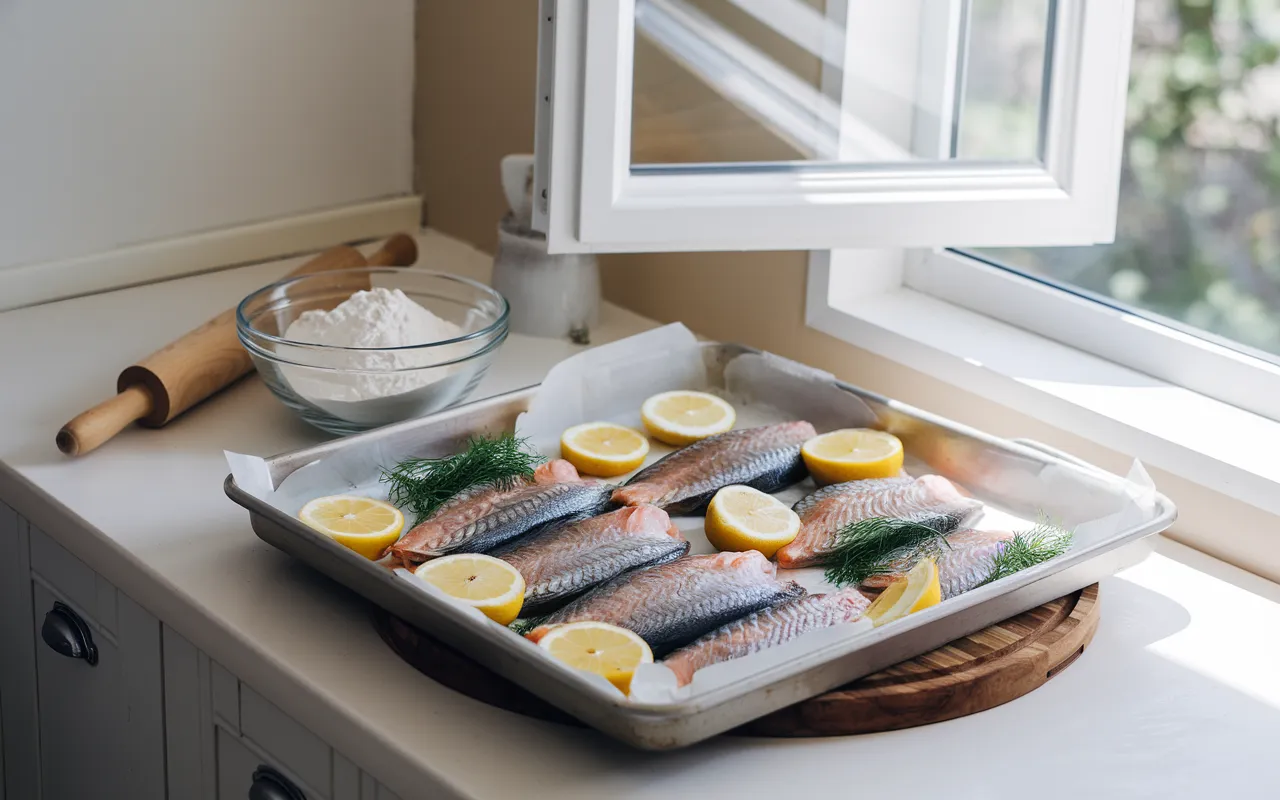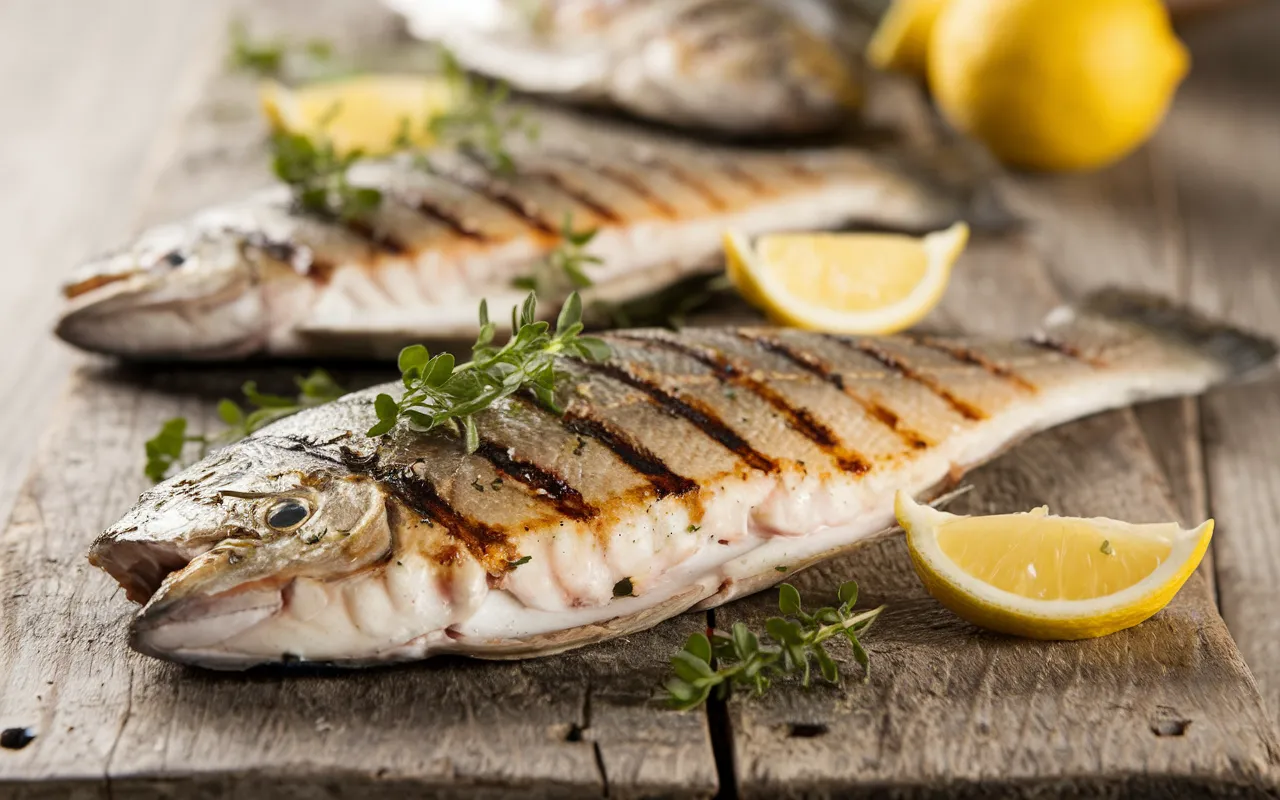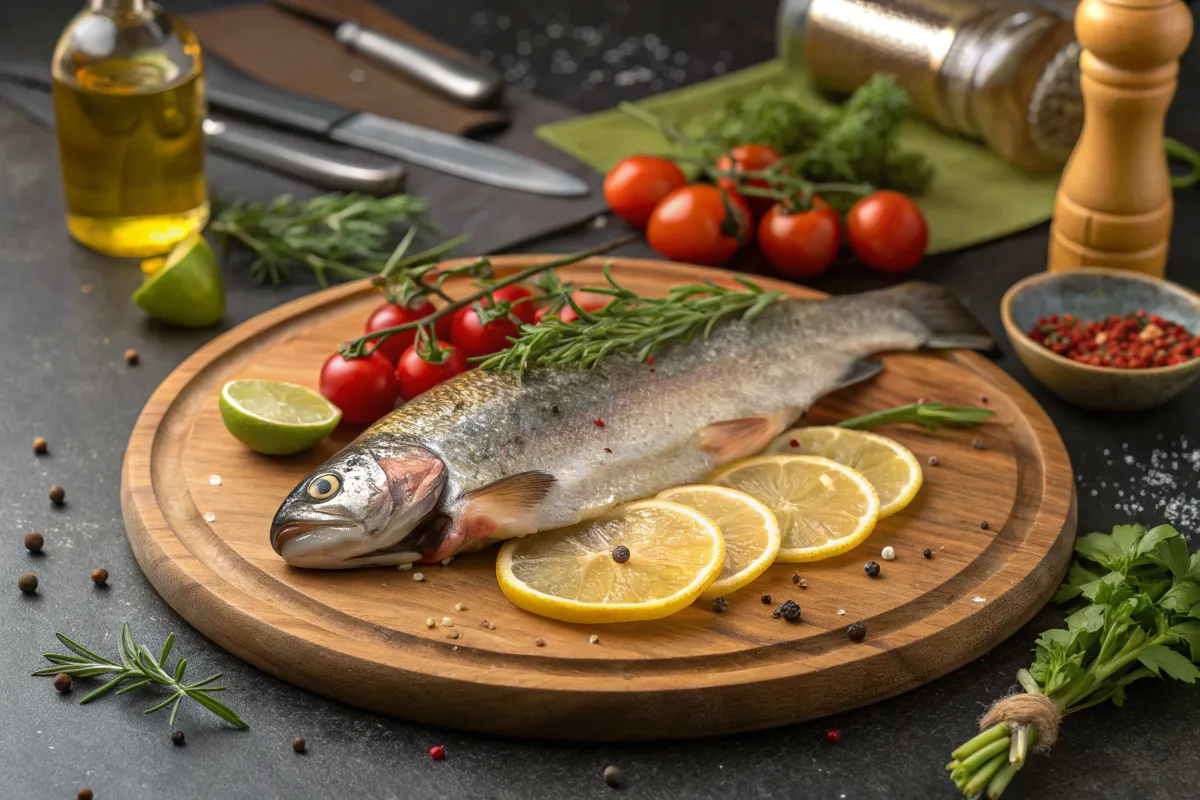Discover the best method of cooking trout for delicious results every time. This guide covers various cooking techniques, ensuring a tasty meal.
Exploring the Best Method of Cooking Trout
What is the best method of cooking trout? This is a common question for both new and experienced cooks. There are several ways to cook trout, each offering unique flavors and textures. This article will explore these different approaches, helping you find the best method. We’ll cover pan-frying, baking, grilling, and more. Therefore, you’ll be ready to prepare a delicious trout meal.
Pan-Frying Trout: A Quick and Tasty Option
Pan-frying is a very popular method for cooking trout. It is quick, and it produces a lovely crispy skin. Furthermore, the flesh stays moist and tender. So, how does this work? First, heat a skillet over medium-high heat. Then add some oil. Next, season the trout fillets with salt and pepper. Place the trout skin-side down in the hot pan. Cook for about 4-5 minutes on each side. However, the cooking time might vary depending on the thickness of the trout. The result is a perfectly cooked trout. Accordingly, many consider this one of the best methods of cooking trout.
Achieving Crispy Skin: The Key to Pan-Frying
Crispy skin is a desirable characteristic of pan-fried trout. To achieve this, ensure the pan is hot before adding the trout. Moreover, pat the trout skin dry with paper towels. This helps remove excess moisture. Hence, the skin gets crispy rather than soggy. Don’t overcrowd the pan. If the pan is too full, the temperature will drop, and the trout won’t sear properly. Finally, avoid moving the trout too much while it cooks. This allows the skin to get nice and golden brown. Consequently, the outcome is a flavorful and texturally pleasing dish.
Seasoning and Oil Selection for Pan-Frying
Seasoning plays an important role in pan-fried trout. Simple salt and pepper work great. However, consider adding other seasonings. For example, garlic powder, paprika, or lemon pepper are delicious options. Likewise, the type of oil used affects the final flavor. Olive oil is a healthy choice, but butter can add a richer taste. However, using a combination of both is a popular option. Therefore, it gives the trout a good sear with a buttery flavor. The flavor compliments the fish very well.
Baking Trout: An Easy and Healthy Approach
Baking trout is another excellent method. It is simple and requires minimal hands-on time. Furthermore, it’s a healthier way to cook fish. To bake trout, preheat your oven to 400°F (200°C). Place the seasoned trout on a baking sheet. Drizzle with some oil and bake for about 12-15 minutes. However, the exact time may vary based on the size of the fish. This method results in moist and flaky trout. Subsequently, it is also considered the best method of cooking trout by some.
Enhancing Flavor with Herbs and Citrus
Baking allows for easy infusion of flavors. Herbs and citrus are excellent for this. For example, place some lemon slices and sprigs of dill inside the trout cavity. In addition, you could sprinkle some herbs over the top. Therefore, this simple addition makes a significant difference. Consequently, the trout comes out with a vibrant, aromatic flavor.
Baking Whole Trout vs. Fillets
Baking works well for both whole trout and fillets. Whole trout tends to remain more moist during the baking process. Also, it can make a more impressive presentation. However, fillets are quicker to cook and easier to handle. Ultimately, your choice depends on personal preference. In either case, baking remains a superb method for cooking trout.
Grilling Trout: A Smoky and Flavorful Choice
Grilling trout gives it a delicious smoky flavor. It also creates a lovely char on the skin. Furthermore, the high heat of the grill sears the outside while keeping the inside moist. To grill trout, preheat your grill to medium-high heat. Oil the grates to prevent sticking. Season your trout and place it on the grill. Cook for 4-5 minutes per side, or until cooked through. This method adds another variation on the best method of cooking trout.
Grilling with Foil: A Mess-Free Option
Grilling trout in foil can make cleanup much easier. Also, it helps keep the fish moist. Simply place the seasoned trout on a piece of foil. Add any herbs or citrus you like. Then, wrap the foil tightly around the trout. Place the foil packet on the grill and cook. This approach is simple and flavorful. Moreover, it allows for easy customization of ingredients.
Tips for Perfect Grill Marks
Beautiful grill marks are a sign of a perfectly grilled trout. To achieve this, ensure your grill is hot before adding the trout. Avoid moving the trout while it’s cooking. Also, using a spatula to gently press down on the fish can help. These small steps can make a big difference. Therefore, it elevates the final dish.
Other Methods: Broiling and Poaching
Besides pan-frying, baking, and grilling, there are other methods. For example, broiling is a quick way to cook trout. It involves using the direct heat of the oven broiler. This method can give a similar result to grilling. Poaching is another method worth mentioning. It involves cooking trout in simmering liquid. Poaching results in a very tender and delicate fish. However, it lacks the crispy skin that many prefer. However, it can also be the best method of cooking trout for a healthy dish.
Broiling for Quick Results
Broiling is a fast and easy way to cook trout. Set your oven to broil and place the seasoned trout on a baking sheet. Watch the trout closely. It can cook quickly under the broiler. You want to cook until the trout is flaky and cooked through. This method is particularly useful when time is short.
Poaching for Delicate Flavor
Poaching is excellent for maintaining the trout’s delicate flavor. Simmer the trout in stock, wine, or water with herbs. The result is a moist and flavorful fish. However, it doesn’t have a crispy skin. Therefore, it may not be everyone’s preferred method. Nevertheless, it’s a great technique to have in your cooking repertoire.
Factors Influencing the Best Method
What is the best method of cooking trout really comes down to your preferences. Several factors can influence this decision. The availability of cooking equipment, time constraints, and flavor preferences all play a role. For instance, if you prefer crispy skin, pan-frying or grilling may be your choice. Comparatively, baking is a good option if you want something easy with minimal cleanup. Equally, poaching is a great method if you want a very tender fish.
Time Constraints and Cooking Equipment
Time is often a major factor. Pan-frying and broiling are quick. Baking is relatively hands-off. Grilling takes a bit more time. Additionally, your available cooking equipment will influence your choice. If you don’t have an outdoor grill, baking or pan-frying are your best bets. Consequently, you need to use the resources available.
Flavor Preferences: What Suits Your Palate
Your preferences for flavors play a significant role. For example, grilling imparts a smoky flavor. Pan-frying is all about crispy skin. Baking allows for easy infusion of flavors with herbs and citrus. Poaching produces a delicate flavor. Therefore, choose a method that matches your liking. Indeed, taste is key.
Tips for Cooking Trout: Ensuring the Best Outcome
Regardless of the chosen method, some tips will guarantee a delicious result. Freshness is crucial. Choose trout that looks vibrant. The flesh should be firm. Also, avoid trout that smells overly fishy. Proper seasoning is another key. Don’t be afraid to use enough salt. Finally, don’t overcook the fish. Trout is done when it is opaque and flakes easily. Therefore, by following these basic tips, anyone can cook trout successfully.
Proper Seasoning Techniques
Proper seasoning makes a significant difference. Salt and pepper are essential, but there’s room for creativity. Add garlic powder, onion powder, paprika, or herbs. Lemon zest is another good additional flavor option. Season both sides of the trout generously. Furthermore, marinate the trout for about 30 minutes if you wish. Accordingly, this will enhance the flavors.
Preventing Overcooking: Recognizing Doneness
Overcooking dries out the trout. To prevent this, cook until the flesh is opaque and flakes easily with a fork. The internal temperature should reach 145°F (63°C). Using a thermometer can help you ensure that the fish is cooked to the correct temperature. Also, remember that the trout will continue to cook a bit as it rests. Therefore, remove it from the heat just before it’s fully cooked.
Serving Suggestions and Side Dishes
Trout compliments a variety of side dishes. For example, steamed vegetables, roasted potatoes, or a simple salad are great options. Lemon wedges are a nice additional touch. Also, consider a creamy sauce or a simple butter sauce to sprinkle on top. Finally, your side dishes should compliment the flavors of the trout.
Trout Recipes and Flavor Combinations
Now, let’s explore some specific recipes. These ideas highlight different ways to prepare trout. Additionally, each recipe emphasizes different flavor profiles. Accordingly, these recipes will help you find your new favorite way of cooking trout. We’ll examine some classic pairings and some more adventurous ideas.
Classic Lemon and Herb Trout
This is a timeless pairing. Combine lemon slices, fresh dill, and thyme. Stuff the trout cavity with these ingredients. Drizzle with olive oil and bake. This method is simple, fresh, and delicious. Indeed, the flavors complement the trout beautifully. Furthermore, it’s a great introduction to cooking trout.
Spicy Southwestern Trout
For a bolder taste, try a southwestern flavor combination. Season the trout with chili powder, cumin, and smoked paprika. Grill the trout and serve with a lime wedge. The smoky and spicy flavors create a unique and satisfying dish. Similarly, a bit of cilantro can elevate this dish.
Mediterranean-Style Trout
For a taste of the Mediterranean, use olive oil, garlic, oregano, and lemon. Moreover, you can add some tomatoes and olives. Specifically, these ingredients bring a bright and flavorful touch to the trout. You can bake or pan-fry the trout using this flavor profile. Therefore, this provides a versatile option.
Almond-Crusted Trout
If you enjoy a bit of crunch, try almond-crusted trout. Dip the trout in egg and coat it with ground almonds. Pan-fry the trout until golden brown and crispy. This variation adds a lovely texture. Additionally, the almond flavor adds a nutty note.
Nutritional Benefits of Trout
Besides being delicious, trout is a very nutritious fish. It is a good source of protein, Omega-3 fatty acids, and various nutrients. Therefore, it is a great choice for a healthy meal. Understanding the nutrients in trout helps you make informed food decisions. Subsequently, you can enjoy a meal that is both delicious and healthy.
Protein Content
Trout is a good source of high-quality protein. Protein is essential for building and repairing tissues. Also, protein helps with satiety. Therefore, trout can help you feel full and satisfied after a meal. Including protein-rich foods in your diet is important.
Omega-3 Fatty Acids
Trout is rich in Omega-3 fatty acids. These healthy fats are good for heart health. Additionally, they help reduce inflammation. Furthermore, Omega-3s are important for brain function. Consequently, including trout in your diet helps you reap these benefits.
Vitamins and Minerals
Trout is also a good source of vitamins and minerals. It contains Vitamins such as B12 and selenium. Likewise, trout offers minerals like potassium. These nutrients are important for overall health. Therefore, eating trout contributes to a well-balanced diet.
Selecting and Storing Fresh Trout
Selecting fresh trout is important for the best results. Look for trout that appears vibrant with clear eyes. The flesh should be firm and not mushy. Also, it should not smell overly fishy. Additionally, proper storage is important for maintaining freshness. Indeed, freshness directly affects the final flavor.
Choosing Fresh Trout
When buying trout, inspect it carefully. The eyes should be bright and clear. The gills should be bright red. Furthermore, the flesh should be firm and not slimy. If you are buying a whole trout, it should not have a strong fishy odor. Consequently, paying attention to these details will help you select a fresh, quality fish.
Proper Storage Techniques
Fresh trout should be stored in the refrigerator. Place it in an airtight container. It is best to use it within one or two days. You can also freeze the trout. Wrap it tightly in plastic wrap and place it in a freezer bag. Frozen trout can be stored for several months. Therefore, proper storage will help preserve freshness and quality.
Variations on Cooking Trout: Different Preparations
Let’s discuss a few more variations on cooking trout. Specifically, we’ll discuss options that incorporate diverse ingredients and techniques. These variations can help you explore your culinary creativity. Thus, you can enhance the flavor and texture of trout.
Trout with Brown Butter and Sage
Brown butter and sage is a classic flavor pairing. This preparation involves cooking butter until it turns a nutty brown color. Sprinkle in some fresh sage leaves. Pour this flavorful sauce over your cooked trout. The result is a sophisticated and satisfying dish. Furthermore, this sauce elevates the flavor of the trout.
Trout with a Lemon-Caper Sauce
Lemon-caper sauce is another excellent choice. This sauce is tangy, bright, and delicious. Combine lemon juice, capers, butter, and a bit of white wine. Sprinkle this sauce over your cooked trout. This creates a lovely dish that pairs well with a variety of side dishes.
Smoked Trout
Smoking trout is a great way to add a smoky flavor. This method requires a smoker. However, it’s a worthwhile process. Additionally, you will need to marinate the trout before smoking. The result is a richly flavored trout with a tender texture. Indeed, this adds a unique flavor profile to the fish.
Troubleshooting Common Trout Cooking Issues
Even with the best instructions, things can sometimes go wrong. Therefore, let’s explore common issues when cooking trout. Consequently, learning how to solve these issues will help you improve your skills. This will help you create perfect trout dishes every time.
Dry Trout
Dry trout is often the result of overcooking. Also, it could be caused by cooking at too high of heat. Make sure you don’t overcook the trout and use enough oil or butter. Monitor the internal temperature. It should reach 145°F (63°C). Additionally, using the foil method for baking or grilling can help retain moisture.
Soggy Skin
Soggy skin usually happens when pan-frying. Ensure the trout skin is dry before cooking it. Also, the pan should be hot before you add the trout. Finally, do not overcrowd the pan. This helps ensure crispy skin. Additionally, using a cast iron pan can help achieve crispiness.
Flavorless Trout
Flavorless trout is often the result of under-seasoning. Do not be afraid to use plenty of salt and other seasonings. Marinating the trout is also a good way to add flavor. You should also make sure your ingredients are fresh for the best results. Therefore, proper seasoning is very important.
Conclusion: Mastering the Art of Cooking Trout
What is the best method of cooking trout? In the end, it’s a matter of personal preference. The methods discussed provide a range of options. Whether you prefer pan-frying, baking, grilling, or something else, there’s a perfect method for you. Ultimately, by understanding these techniques, you can confidently cook trout. Thus, you can now create a delicious and satisfying meal. Subsequently, you can enjoy cooking trout at home.
Frequently Asked Questions
How do you prepare trout to eat?
First, you must clean the trout. You will then need to season the fish with salt, pepper, and other spices. Additionally, you can add herbs or lemon. Finally, decide if you want to bake, pan fry, or grill your trout.
What temperature should trout be cooked at?
The internal temperature of cooked trout should reach 145°F (63°C). Furthermore, use a meat thermometer to ensure proper cooking. This helps ensure the trout is safe and cooked through.
Should you wash rainbow trout before cooking?
Generally, it is best to rinse the trout under cold water before cooking. However, pat it dry with paper towels before seasoning. This helps the skin get crispy if you plan to pan-fry.
What is the best thing to use for trout?
Lemon, butter, garlic, and fresh herbs are compatible with trout. Moreover, using a combination of seasonings can really improve the trout’s flavor. Additionally, don’t forget simple salt and pepper.



